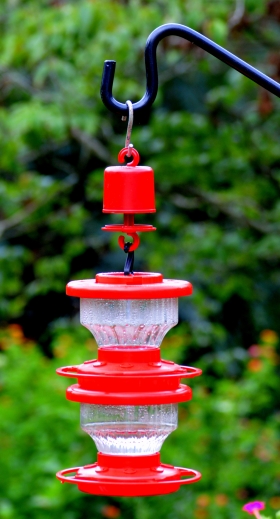By Terry W. Johnson
Now that we have celebrated Memorial Day, Georgia hummingbird enthusiasts know the time is drawing near when the numbers of hummingbirds visiting their feeders will soon be rising. They also realize that more ants, yellow jackets, honeybees and wasps will be converging on hummingbird feeders in search of a sugary meal. This can cause problems for hummingbirds and humans alike.
Knowing what lies in store, let's take a quick look at some strategies you can employ to thwart the advances of these insects.
For many years, the only way you could stave off assaults from an army of ants trying to take control of your feeder was smearing grease or petroleum jelly on the shepherd's hook or pole supporting the feeder. This works because ants will not crawl across sticky grease.
However, I have found that when spread on wood poles, some types of greases are absorbed by the wood and are effective only when they are continually reapplied. But even applying the grease is a messy proposition, at best. In addition, some homeowners consider a pole smeared with grease unattractive.
During the latter part of the 20th century, an unknown inventor came up with something called the ant moat. This remarkably simple device has been an improvement over applications of grease.

The ant moat looks much like the removable top of an aerosol can. A piece of heavy wire runs through the bottom of the moat. This wire is bent in such a way as to form hooks above and below the moat. This permits the moat to be attached to the structure providing support for the feeder, while the feeder attaches to the bottom hook. When in place, water is poured into the moat.
This gadget thwarts ants trying to reach a feeder because the insects must cross the water-filled moat to reach the feeder. Fortunately, when most ants encounter the mini-water obstacle, they don't want to dip their six legs into the water and turn around and leave.
Ant moats can be bought or made at home. If you make yours, do not forget to seal the spot where the wire runs through the bottom of the moat.
If you use an ant moat, you will notice that the water disappears over time. Some is lost to evaporation. Birds also will often drink the water.
It is a good idea empty the water every few days. This prevents mosquito larvae from living in it.
If you would rather not deal with a water-filled moat, you can make a mini-moat using the plastic top found on a soft drink bottle. Simply run a stiff wire through the center of the top. Twist a hook on each end of the wire.
Fill the small lid with petroleum jelly or grease. Then place the device above the feeder with the grease-filled side of the moat facing up.
In recent years, devices containing ant repellent have shown up in stores. Like moats, they are designed to be placed between the structure supporting the feeder and the feeder itself. They are nothing more than plastic shells containing disks impregnated with an insecticide such as permethrin. The manufacturers claim the chemicals do not pose a threat to ants, birds or other wildlife. The chemicals contained within the disks act as an ant repellent.
I have long had the chronic problem of tiny ants reaching my feeders and drowning in the nectar. Looking for a solution a few years ago, I decided to try one of these relatively new contraptions. The one I tested was called AntGuard.
Admittedly, I was skeptical it would work as advertised. As it turned out, the devices worked great and turned out to be the simplest solution to my ant problem that I have yet come across.
At the end of the hummingbird season I stored the AntGuards in a sealed plastic bag. The next year, I took them out of the bag and used them again. I was pleasantly surprised that they worked just as well for a second season.
Keeping bees, hornets and their kin away from feeding portals requires different strategies. Some hummingbird feeders are equipped with bee guards. The bright yellow guards fit over the feeder's feeding stations.
A guard increases the distance from its waffle-like guard to the nectar. Since a hummingbird has both a long tongue and bill, it can stick its bill through one of the holes in the guard and easily drink the sugar water held in the feeder. Bees cannot reach the sugary liquid because they have short “tongues."
Bees can also be foiled by smearing vegetable oil over the surface of the feeder adjacent to feeding portals with a cotton swab or your finger. Since bees do not like to walk around on greasy surfaces, they stay away. Vegetable oil can also be sprayed around a feeder's dining areas. However, if you use a vegetable oil spray, do not spray the perches.
In late summer, yellow jackets pose a real danger for both hummingbirds and the people that maintain feeders. Neither we nor the birds want to be stung. With that in mind, a yellow jacket trap will reduce the numbers of these stinging insects swirling around your feeder.
A trap can be made by cutting four 1-inch holes equidistant apart about half way up the side of a plastic 2-liter soft drink bottle. Fill the bottom of the bottle with sugar water to a depth of about 2 inches. Then add a few drops of liquid soap and hang the trap near your hummingbird feeders.
The stinging insects will enter the trap and drown. The trap containing the dead insects can then be safely tossed into the trash.
A word of caution: Don't use a trap if honeybees are congregating around your feeders. The last thing you want to do is destroy these valuable insects.
I suspect that unwanted insect pests have been plaguing hummingbird feeders since the first hummingbird feeder was hung up in a New England backyard more than a century ago. Although we have been winning our share of the battles with these relentless foes as of late, I am confident that this war will continue indefinitely.
Terry Johnson is a former Nongame program manager with the Wildlife Resources Division, a backyard wildlife expert, and executive director of TERN, the friends group of the Nongame Conservation Section. (Permission is required to reprint this column. Contact rick.lavender@dnr.ga.gov.) Learn more about TERN, The Environmental Resources Network at http://tern.homestead.com.


















